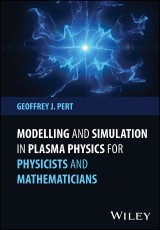Details

Modelling and Simulation in Plasma Physics for Physicists and Mathematicians
1. Aufl.
|
125,99 € |
|
| Verlag: | Wiley |
| Format: | EPUB |
| Veröffentl.: | 30.05.2024 |
| ISBN/EAN: | 9781394239214 |
| Sprache: | englisch |
| Anzahl Seiten: | 288 |
DRM-geschütztes eBook, Sie benötigen z.B. Adobe Digital Editions und eine Adobe ID zum Lesen.
Beschreibungen
<p> <b>Unveiling the Secrets of Plasma Physics: A Practical Guide to Computational Simulations</b> <p>Plasma physics focuses on the most abundant state of matter in the universe, corresponding to ionized gas comprising ions and electrons. It can be created artificially and has a huge range of technological applications, from television displays to fusion energy research. Every application of plasma technology requires its own numerical solution to the complex physical and mathematical equations which govern the research field of plasma physics. <p><i>Modelling and Simulation in Plasma Physics for Physicists and Mathematics </i>offers an introduction to the principles of simulating plasma physics applications. It provides knowledge not only of the fundamental algorithms in computational fluid mechanics, but also their specific role in a plasma physics context. In addition, the book dissects the challenges and advancements, unveiling the delicate balance between accuracy and computational cost. <p><i>Modelling and Simulation in Plasma Physics for Physicists and Mathematics </i>readers will also find: <ul><li>Cutting-edge computational insights where powerful simulations meet theoretical complexities, providing physicists and mathematicians a gateway to cutting-edge research. </li><li>An overview of programming language-agnostic code generation and the construction of adaptable models that resonate with the intricate dynamics of plasma physics, ensuring precision in every simulation. </li><li>Advanced simplification strategies, including time splitting, analytic models, averaged rates, and tabular material, offering scientists and engineers a roadmap to balance computational demands with scientific rigor.</li></ul> <p><i>Modelling and Simulation in Plasma Physics for Physicists and Mathematics </i>is ideal for plasma physicists, students, and engineers looking to work with plasma technologies.
<p>Preface</p> <p><b>1 Foundations of Computational Fluid Mechanics</b></p> <p>1.1 Basic Concepts of Finite Difference Integration</p> <p>1.2 Basic Concepts of Fluid Mechanics</p> <p>1.3 The Basic Equations of Fluid Mechanics</p> <p>1.4 Ideal (Dissipationless) Flow - Hyperbolic Equations</p> <p>1.5 Formal Solution</p> <p>1.6 Discontinuities</p> <p>1.7 Plasma Fluid Dynamics</p> <p>1.8 Basic Principles of Finite Differencing</p> <p>1.9 Numerical Fluid Approximations</p> <p>1.10 Grid Geometry</p> <p>1.11 Control Volume Differencing</p> <p>1.12 Mesh types</p> <p><b>2 Analytic and Quasi-Analytic Approximations</b></p> <p>2.1 Analytic and Quasi-Analytic Methods</p> <p>Appendix 2.A The Nemchinov conjecture</p> <p>Appendix 2.B The energy integral</p> <p><b>3 Numerical Fluid Dynamics</b></p> <p>3.1 Eulerian Schemes</p> <p>3.2 Steady State Problems</p> <p>3.3 Spatial Differencing</p> <p>3.4 Generalised Euler Schemes</p> <p><b>4 Lagrangian Systems</b></p> <p>4.1 Lagrangian Fluid Dynamics</p> <p>4.2 One Dimensional von Neumann-Richtmyer Algorithm</p> <p>4.3 Multi-Dimensional Lagrangian Schemes</p> <p>4.4 Choice of Method</p> <p><b>5 Arbitrary Lagrangian-Eulerian Schemes</b></p> <p>5.1 Introduction</p> <p>5.2 Step 1: The Lagrangian Stage</p> <p>5.3 Step 2: The Iteration Stage</p> <p>5.4 Step 3: Mesh generation</p> <p>5.5 Step 4: Rezoning</p> <p><b>6 Hybrid or 1 1/2 d Schemes</b></p> <p>6.1 Introduction</p> <p><b>7 Magneto-hydrodynamics</b></p> <p>7.1 Introduction</p> <p>7.2 The MHD Equations</p> <p>7.3 Self-generated Fields</p> <p><b>8 Monte Carlo Schemes</b></p> <p>8.1 Monte-Carlo methods</p> <p>8.2 Monte Carlo Integration</p> <p>8.3 Random Walks</p> <p>8.4 Nuclear Reactor Criticality</p> <p>8.5 Thermodynamic Properties and Equation of State</p> <p>Appendix 8.A Kinematics of Elastic Scattering</p> <p><b>9 Particle transport</b></p> <p>9.1 Particle transport</p> <p><b>10 Numerical Diffusion Schemes</b></p> <p>10.1 Introduction</p> <p>10.2 Split time step and ADI Methods for Solving Diffusion Problems in Orthogonal Cartesian Grid Systems</p> <p>10.3 The Diffusion Matrix</p> <p>Appendix 10.A Thomas algorithm -Tri-diagonal matrix equation solver</p> <p><b>11 Particle path tracking</b></p> <p>11.1 Introduction</p> <p>Appendix 11.A Bunemann-Boris algorithm</p> <p>Appendix 11.B Stability of the 1d electrostatic model</p> <p>11.B.1 Time step limitation</p> <p>11.B.2 Space step limitation</p> <p>11.B.3 Stability of the 1D electro-magnetic model</p> <p><b>12 Ion-electron equilibration</b></p> <p><b>13 Ionisation-recombination Models</b></p> <p>13.1 Introduction</p> <p>13.2 Collisional-radiative model</p> <p>13.3 Two stage model</p> <p>Appendix 13.A Solution of the Collisional radiative equations</p> <p>Appendix 13.B A theorem on determinants</p> <p>Appendix 13.C An algorithm using the exact solution</p> <p>Supplement M.1 Partial Differential Equations</p> <p>M.1.i General Form of First-Order Partial Differential Equations</p> <p>M.1.ii Linear second order partial differential equations</p> <p>M.1.iii Separation of variables</p> <p>M.1.iv Boundary conditions</p> <p>Supplement M.2 Stiff Equations</p> <p>Supplement M.3 Weak solutions</p> <p>Supplement M.4 Operator Splitting</p> <p>M.4.i Split time step</p> <p>Supplement M.5 Statistics Primer</p> <p>M.5.i Basic stochastic nomenclature and results</p> <p>M.5.ii Moments</p> <p>M.5.iii Covariance, Correlation and Regression</p> <p>M.5.iv Elementary Statistical Results</p> <p>M.5.v Variance of a Sum of Samples</p> <p>M.5.vi Variance of the mean</p> <p>M.5.vii Weighted averaging</p> <p>Supplement M.6 Numerical Solution of Poisson’s Equation</p> <p>M.6.i One dimension</p> <p>M.6 .ii Two dimensions 223</p> <p>Supplement M.7 Compressible Gas Potential Flow</p> <p>M.7.i Compressible Gas Potential Flow</p> <p>M.7.ii Perturbation Flow</p> <p>M.7.iii The General Solution</p> <p>Supplement M.8 Viscous Incompressible Flow</p> <p>M.8.i Introduction</p> <p>M.8.ii Marker-in-Cell</p>
<p><b>Geoffrey Pert, PhD,</b> is Emeritus Professor, Department of Physics, University of York, UK. He has continuously been involved in research in plasma physics, primarily the interaction of high-power lasers with materials, since first studying the subject as a research student in the 1960's. Professor Pert is also a Fellow of the Royal Society.
ERROR
Diese Produkte könnten Sie auch interessieren:

Systemtheoretische Grundlagen optoelektronischer Sensoren
von: Herbert Jahn, Ralf Reulke
Preis: 79,99 €
-
-
© 2024 media control GmbH
Alle Preise enthalten die gesetzliche Mehrwertsteuer. - AGB
- Impressum
- Datenschutzerklärung
- Kontakt
- FAQ
- Mein Konto
- Home
- Erweiterte Suche
- Widerrufsrecht
- Reader-Software
- Desktop-Ansicht
- Gutschein-Code einlösen
- English

